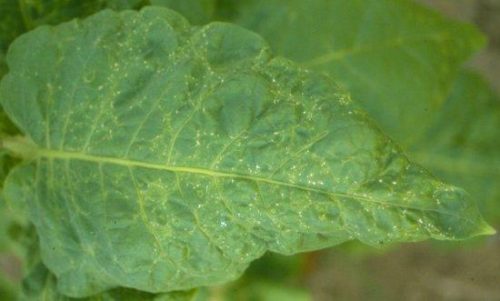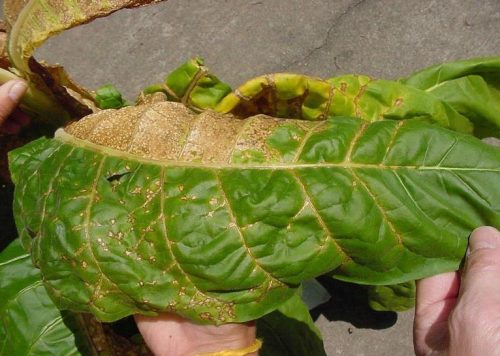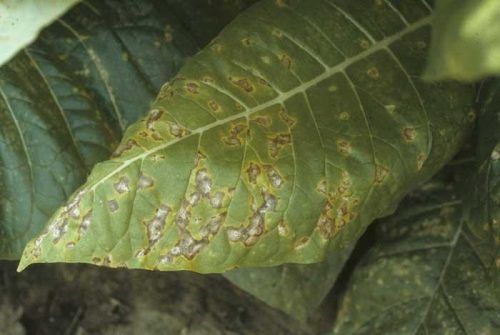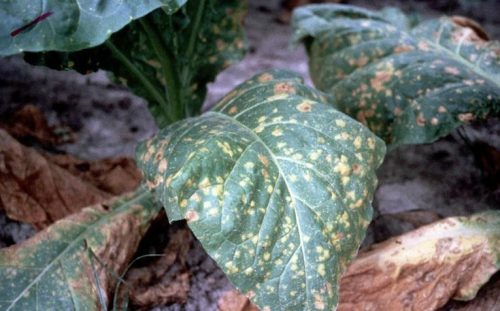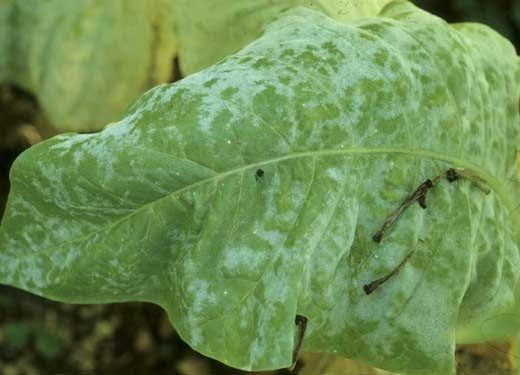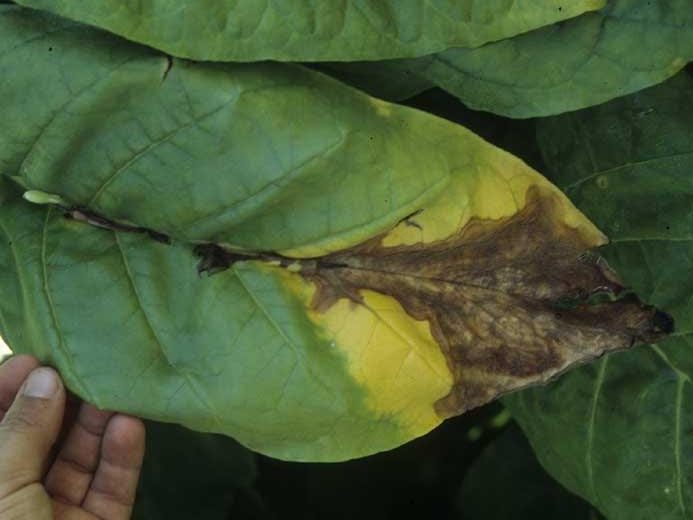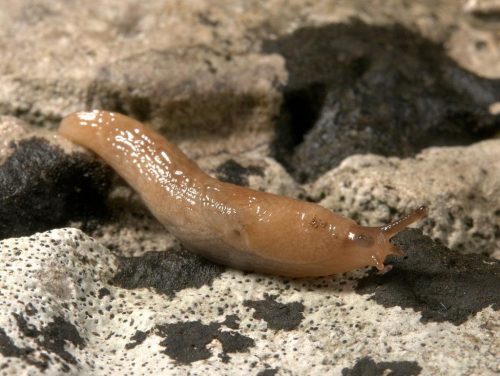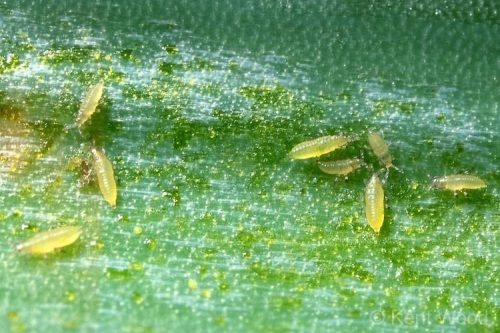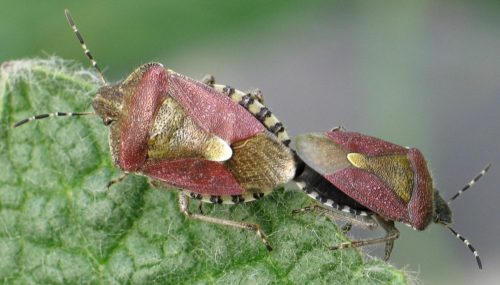Tobacco treatments, pest and disease control
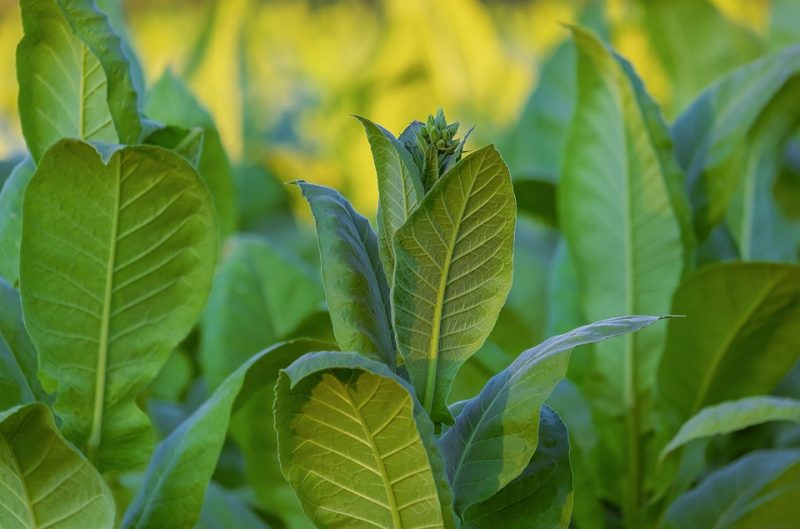
Tobacco (Nicotiana tabacum) is a plant that belongs to the Solanaceae family and is cultivated for its leaves. It is the raw material used in the tobacco industry, one of the most profitable industries in the world. It is a demanding crop, and the processing of tobacco leaves after harvest is quite difficult to achieve without proper technical means. On the other hand, the crop can be affected by a number of diseases and pests.
The main diseases of tobacco
Tobacco mosaic (Tobacco mosaic virus)
It is one of the most dangerous diseases for this plant. Dark green spots appear along with the tobacco leaves, arranged along the ribs, and light green spots appear in the space between the ribs. As a result of these symptoms, the leaves acquire a mosaic appearance. The attacked plants do not develop normally and the leaves remain small and deformed. After the infection has set in, the leaves at the top of the plant are narrow and have a twisted edge towards the topside. The disease progresses, and brown spots appear on the basal leaves. In severe cases, the affected tissues dry out and fall, leaving only the ribs of the leaves. The virus is transmitted through direct contact between plants or it is transported from one plant to another by humans, tools, or equipment.
Prevention and control measures:
- disinfecting the areas where seedlings are grown;
- using healthy planting material;
- disinfecting the agricultural tools and machines;
- cultivating resistant varieties;
- removing the attacked plants from the crop.
Tomato spotted wilt virus
The disease appears shortly after planting. The first symptoms are the yellowing of the ribs and the appearance of large yellow-necrotic spots on the basal leaves. The leaves curl up to the underside and turn yellow. In most cases, whitish-gray spots or whitish stripes may appear on the leaves. Following the attack, the plants remain small, wither, and gradually die. The virus is transmitted by tobacco thrips.
Prevention and control measures:
- applying insecticides to control the vector;
- disinfecting the substrate for the seedbeds;
- cultivating resistant varieties;
- destroying the weeds in the crop.
Tobacco wildfire disease (Pseudomonas syringae pv. tabaci)
It is a very dangerous bacteriosis that can destroy large areas of the tobacco crop in a very short time. The disease attacks in all stages of vegetative growth. In seedbeds, hydrolyzed spots appear on the edge of the leaves, at first dark green, and then they become brownish-black. The seedlings dry up and rot. Small yellow spots appear on the leaves of mature plants, surrounded by a rust-brown border. The attacked tissues dry up and fall, the plants having a sifted appearance.
Prevention and control measures:
- disinfecting the soil from the seedbeds;
- disinfecting the seeds before sowing;
- applying treatments to seedlings;
- balanced fertilization;
- cultivating resistant varieties;
- destroying attacked leaves.
Blue mold (Peronospora hyoscyami f.sp. tabacina)
Due to the significant damages it causes, blue mold is one of the most dangerous diseases of tobacco. The fungus can attack both the mature plants and the seedlings. Yellow spots with pale edges appear on the top side of the leaves. Next to these spots, on the underside, a gray-purple fuzz develops. The attacked plants no longer grow, the top of the stem turns yellow, and the leaves bend towards the ground.
Prevention and control measures:
- disinfecting the soil, tools and agricultural equipment;
- a correct crop rotation;
- carrying out treatments with specific fungicides.
Recommended products
-
You can find products on a different store
Change Store -
You can find products on a different store
Change Store -
You can find products on a different store
Change Store -
You can find products on a different store
Change Store -
You can find products on a different store
Change Store -
You can find products on a different store
Change Store -
You can find products on a different store
Change Store -
You can find products on a different store
Change Store -
You can find products on a different store
Change Store -
You can find products on a different store
Change Store -
You can find products on a different store
Change Store -
You can find products on a different store
Change Store -
You can find products on a different store
Change Store -
You can find products on a different store
Change Store -
You can find products on a different store
Change Store -
You can find products on a different store
Change Store -
You can find products on a different store
Change Store -
You can find products on a different store
Change Store -
You can find products on a different store
Change Store -
You can find products on a different store
Change Store -
You can find products on a different store
Change Store -
You can find products on a different store
Change Store -
You can find products on a different store
Change Store -
You can find products on a different store
Change Store
Powdery mildew (Erysiphe cichoracearum)
It is a disease that frequently attacks the tobacco crop, in favorable years causing damages of up to 50%. The symptoms usually appear in late summer. On the basal leaves develops a fine white felt, which represents the mycelium of the fungus. The disease evolves, the felt becomes dusty, and small black spots appear on the surface that represents the fructification of the fungus. The felt spreads rapidly and covers the entire leaf. After the attack, the leaves dry out and become brittle.
Prevention and control measures:
- a correct crop rotation;
- proper agrotechnics (weed control, deep plowing);
- harvesting at the optimum time;
- cultivating resistant varieties;
- carrying out treatments with specific fungicides.
Recommended products
-
You can find products on a different store
Change Store -
You can find products on a different store
Change Store -
You can find products on a different store
Change Store -
You can find products on a different store
Change Store -
You can find products on a different store
Change Store -
You can find products on a different store
Change Store -
You can find products on a different store
Change Store -
You can find products on a different store
Change Store -
You can find products on a different store
Change Store -
You can find products on a different store
Change Store -
You can find products on a different store
Change Store -
You can find products on a different store
Change Store -
You can find products on a different store
Change Store -
You can find products on a different store
Change Store -
You can find products on a different store
Change Store -
You can find products on a different store
Change Store -
You can find products on a different store
Change Store -
You can find products on a different store
Change Store -
You can find products on a different store
Change Store -
You can find products on a different store
Change Store -
You can find products on a different store
Change Store -
You can find products on a different store
Change Store -
You can find products on a different store
Change Store -
You can find products on a different store
Change Store
Grey mould (Botrytis cinerea)
The fungus causes damage in seedbeds, but also in the field. The symptoms manifested on the seedlings are represented by the appearance of a gray mold, which covers the stem and the leaves. The attack occurs when the seedling is ready for transplanting. The plants wither, fall to the ground, and rot. The mature plants have large yellow spots on the basal leaves. The attacked tissues dry out and are surrounded by a yellow area. In wet weather, the fungus attacks the stems and petiole of the leaves. Strongly attacked plants wither and die.
Prevention and control measures:
- treating the seeds;
- airing the seedlings;
- carrying out treatments during the vegetative growth period with specific fungicides.
The main pests of tobacco
Grey field slug (Deroceras agreste)
It is a polyphagous species that attacks many plants, flowers, grapevines, etc. It also causes great damage to tobacco crops. It pierces the leaves, and as the attack progresses, the entire foliage of the plant is destroyed.
Control methods:
- applying treatments with specific insecticides.
Tobacco thrips (Thrips tabaci)
It produces 3 generations per year and overwinters in all development stages, in the soil. It is a polyphagous species that attacks several species of cultivated or spontaneous plants. Adults and larvae feed on the intracellular fluid of the plants, slowing down their growth and development. On hot summer days, the leaves wither. Thrips also cause indirect damage through the transmission of viruses.
Prevention and control measures:
- applying treatments with specific insecticides.
Sloe bug (Dolycoris baccarum)
It produces one generation per year and overwinters as an adult in the foliage of forests or under the plant remains from the surface of the soil. It is a polyphagous species, which is present in most crops. Strong attacks cause a decrease in the number of flavonoids and sugars, which give tobacco its flavor. Also, because of the stings, the leaves can no longer be twisted for obtaining cigars.
Prevention and control measures:
- applying treatments with specific insecticides.














































































































































































































































































































































































































































